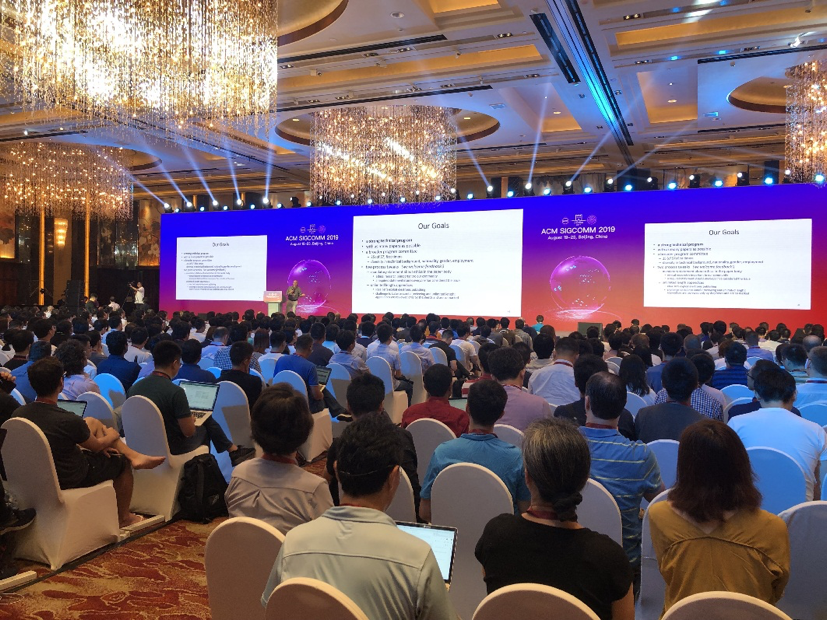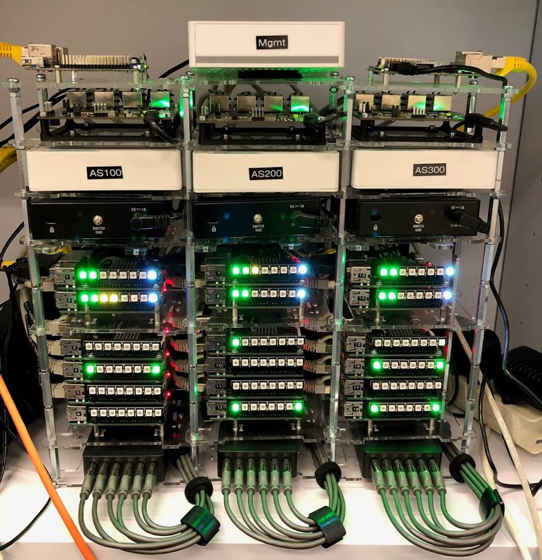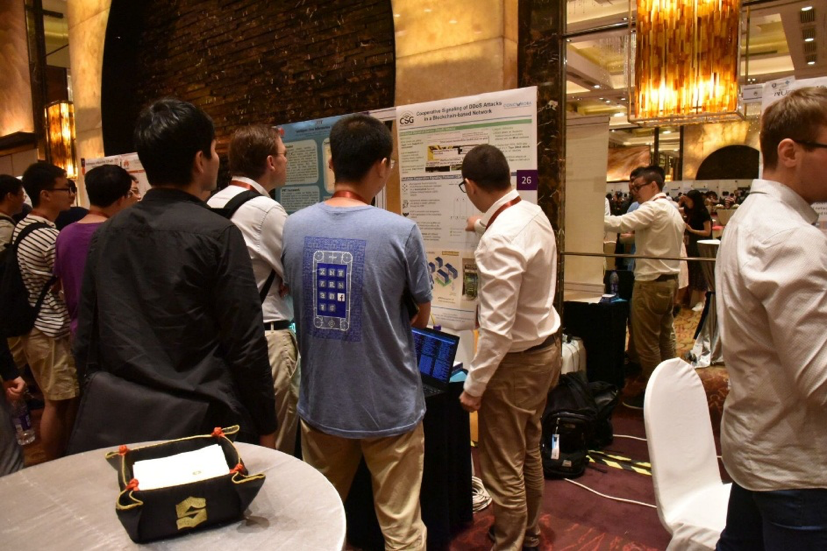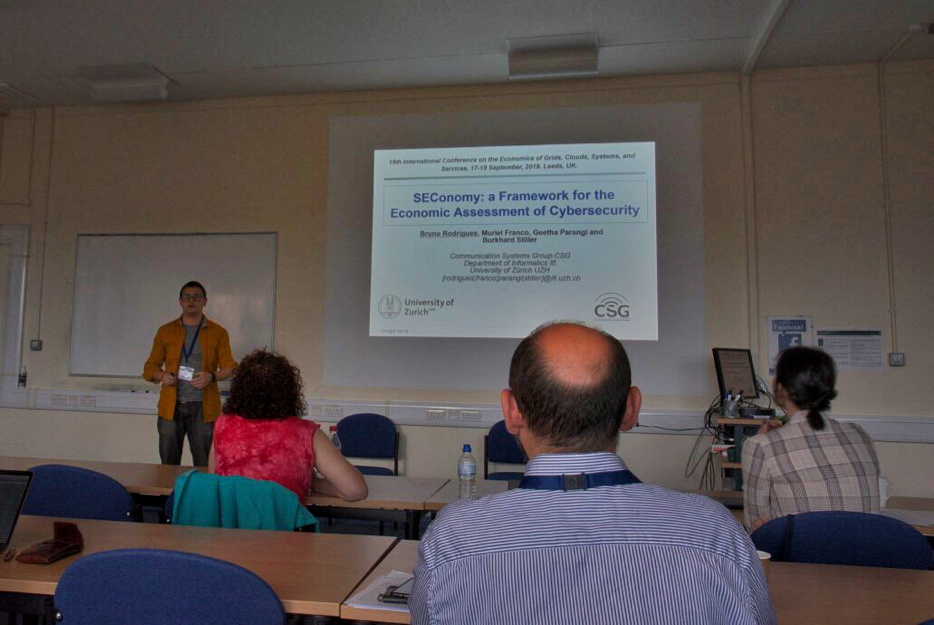CONCORDIA’S Attendance at ACM SIGCOMM 2019 and GECON 2019
The Communication Systems Group CSG of the University of Zürich UZH presented its current contributions to CONCORDIA at two conferences, ACM SIGCOMM 2019 and GECON 2019 (being held, respectively, in Beijing, China and in Leeds, United Kingdom). While SIGCOMM is one of the leading conferences in the area of computer networking, always presenting impactful innovations by the leading universities in the world, GECON targets the crossroads of computer networks, distributed systems, and their economic aspects. This blog post summarizes the output of these experiences organized in two sections, one for each conference.
ACM SIGCOMM 2019
While about 1,200 attendees overall had been accredited for this year’s ACM SIGCOMM 2019 (https://conferences.sigcomm.org/sigcomm/2019/) in Beijing, China, many companies, well besides the main sponsors, did show their interests in SIGCOMM topics (cf. Figure 1). Thus, the interest in security, especially DDoS mitigation work, was very considerable. Already during the CSG’s demo setup on BloSS (“Blockchain Signaling System”) already many people were surrounding the site and asking questions on which type of hardware and switches are used and other hardware-related aspects.

The main motivation for building such a distributed network defense is given by the exponential increase of traffic volume and the number of insecure Internet of Things (IoT) devices, which are empowering Distributed Denial-of-Service (DDoS) attacks to a new era in which attacks became a top security threat to service providers around the world. In such a scenario, existing DDoS defense mechanisms lack resources and flexibility to cope with attacks by themselves. By utilizing other companies’ resources, the burden of the mitigation can be shared. In this regard, new approaches in technology developments, especially Blockchains and Smart Contracts, can be used as a basis for distributing attack information – not the attack themselves obviously – across multiple domains. For instance, SDN (Software-Defined Networking) and NFV (Network Function Virtualization) enables the scaling of defense capabilities on demand.
Thus, a cooperative defense is an alternative to cope with large-scale DDoS attacks, where the mitigation takes place at the egress point of the attack. Advantages over traditional/on-premise defenses have been widely recognized in the literature [1,2,3]. Cooperative defenses allow, for example, to combine detection/mitigation capabilities of different domains, to reduce the detection/mitigation overhead at a single point, and to block malicious traffic near its source. However, there is still no widespread deployment of such a cooperative defense system.
Specifically, Blockchains in the context of a cooperative defense can (1) reduce the complexity of operation and coordination by using existing infrastructure to distribute rules without specialized registries or protocols, (2) foster a trusted cooperation due to its transparency and decentralized characteristics. Also, it can provide (3) financial incentives, which foster cooperative behavior among service providers. The Blockchain Signaling System (BloSS) – developed by the CSG@UZH – presents such a system and its methods built upon these technical basics to demonstrate major benefits and the feasibility of the approach (cf. Figure 2).

The demonstration of the “Cooperative Signaling of DDoS Attacks in a Blockchain-based Network” by Bruno Rodrigues from the Communication Systems Group CSG, Department of Informatics IfI, University of Zurich UZH had been presented during the very busy ACM SIGCOMM 2019 Demo Session (cf. Figure 3). This work had been supported partly by UZH and partly by the Concordia EU project. Additionally, for attending ACM SIGCOMM 2019 Muriel Franco from the CSG did receive an ACM SIGCOMM student travel grant, which enabled him to travel jointly with Bruno, supporting him with the demo’s hardware transport, local demo setup preparations, and running the demonstrator on site. The corresponding demonstration documentation of the BloSS approach and basic setup is available at: https://dl.acm.org/citation.cfm?id=3342300.

GECON 2019
GECON (here the 16th International Conference on Economics of Grids, Clouds, Systems, and Services) is a conference addressing the community focusing on the crossroads of computer science and economics. GECON 2019 (http://2019.gecon-conference.org/) had way fewer participants and was being held at the University of Leeds, Leeds, United Kingdom. The conference had a friendly environment to promote networking and the exchange of ideas toward distributed systems and their economic aspects. Furthermore, the conference showed a 25% paper acceptance rate, which makes it competitive for research in computer science/economics topics. In this regard, GECON was the perfect environment to present a first view on Cybersecurity economic aspects being started and developed within the CONCORDIA context.
Also motivated by the high number of cyber threats and especially many economic aspects involved in cybersecurity, it is imperative to understand the economics behind these activities. For example, the United States of America (U.S.A.) released in 2018 an estimate of costs related to malicious cyber activities of around 57 and 109 billion USD for incidents appearing only in 2016 [4]. These numbers involve not only losses at the initial target and economically linked firms derived from attacks, but also incurs in costs involving the maintenance and improvement of respective systems security. Further, Gartner [5] corroborates with the U.S.A. estimate and predicts for 2018 and 2019 a value of 114 and 124 billion USD, respectively, representing an increase of approximately 8% for one country only. While cost numbers are not precise on a global scale, there exist estimates, such as from [6], which predict costs related to cybersecurity activities to exceed 1 trillion USD cumulatively for the five years from 2017-2021, while especially taking into account the growing number of Internet of Things (IoT) devices.
In this regard, the CSG started and developed the SEConomy framework, which follows a strictly step-based framework to measure the economic impact of cybersecurity activities in a distributed ecosystem with several actors involved. In this regard, SEConomy presents such a 5 steps approach. Through the mapping of actors, responsibilities, inter-dependencies, and risks, it is possible to develop specific economic models, which can provide in a combined manner a quite accurate picture of cybersecurity economic impacts. The SEConomy Framework as shown in Figure 4 focuses on the interplay of the cybersecurity world and economics by mapping actors, activities, and processes to their impacts on the different cybersecurity activities. The related SEConomy talk was presented by Bruno Rodrigues from CSG in the second day of the event located Session 4 on “Economy Assessment, Business, and Pricing Models”. Being imperative to understand significant dependencies between complex and distributed systems (e.g., supply-chain), as well security and safety risks associated with each actor determine a crucial facet. The full set of GECON 2019 proceedings did appear in Springer’s Lecture Notes on Computer Science Series (LNCS).

References
[1] Andrew Mortensen, Flemming Andreasen, Tirumaleswar Reddy, ChristopherGray, Rich Compton, and Nik Teague. 2018.Distributed-Denial-of-Service OpenThreat Signaling (DOTS) Architecture. Internet-Draft draft-ietf-dots-architecture-06. Internet Engineering Task Force. https://datatracker.ietf.org/doc/html/draft-ietf-dots-architecture-06. Work in Progress.
[2] Tao Peng, Christopher Leckie, and Kotagiri Ramamohanarao. 2007. Survey ofNetwork-based Defense Mechanisms Countering the DoS and DDoS Problems.ACM Computing Surveys (CSUR)39, 1 (2007), pp. 03–15
[3] Saman T. Zargar, James Joshi, and David Tipper. 2013. A Survey of DefenseMechanisms Against Distributed Denial of Service (DDoS) Flooding Attacks.IEEE Communications Surveys Tutorials15, 4 (Fourth 2013), pp. 2046–2069.
[4] WhiteHouse: The Cost of Malicious Cyber Activity to the U.S. Economy. WhiteHouse , 2018, https://www.whitehouse.gov/wp-content/uploads/2018/03/The-Cost-of-Malicious-Cyber-Activity-to-the-U.S.-Economy.pdf
[5] S. Moore: Gartner Forecasts Worldwide Information Security Spending to Exceed124 Billion in 2019. Gartner , 2018, https://www.gartner.com/en/newsroom/press-releases/2018-08-15-gartner-forecasts-worldwide-information-security-spending-to-exceed-124-billion-in-2019
[6] S. Morgan: 2019 Official Annual Cybercrime Report. Herjavec Group, 2019, https://bit.ly/2TouUT2
(by Bruno Bastos Rodrigues, Universität Zürich)
